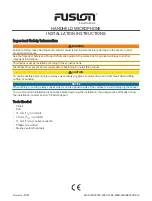
PRIMAAX
®
EX / PRIMAAX
®
for International Truck Vehicles
17730-283
37
Alignment & Adjustments
4. Using the measurements from the Drive Axle Alignment Inspection Procedure, Step 11,
determine which QUIK-ALIGN collar will need adjusting to correct the axle alignment.
SERVICE HINT
If the axle can be adjusted on both sides, begin the adjustment on the side that is furthest out of
specification.
NOTE
Use a new QUIK-ALIGN pivot bolt kit (see the Parts List Section of this publication) for any axle
alignment or disassembly of the QUIK-ALIGN connection. This will help ensure that the proper
clamp load is applied to the connection and help prevent the joint to slip in service.
5. On the side being adjusted, remove the old QUIK-ALIGN fastener and replace it with a new
QUIK-ALIGN fastener. Snug the new QUIK-ALIGN fastener to 50/100 foot pounds. This will hold
the eccentric flanged collar in place against the frame hanger face, and within the adjustment
guide, but loose enough to permit the QUIK-ALIGN eccentric flanged collar to rotate freely.
6. See additional Air Spring Warnings and Instructions in the Important Safety Notice Section
of this publication prior to deflating or inflating the suspension system.
7. Inflate the suspension by connecting the height control valve linkage to the height control
valve arm. Verify the air springs inflate uniformly without binding.
8. Verify the ride height is within specification, refer to vehicle manufacturer for proper ride
height adjustment.
NOTE
When adjusting the alignment of an axle, the fasteners connecting the longitudinal torque
rod to the frame hanger, above the QUIK-ALIGN collar being adjusted, must be loose at the
frame hanger. This will allow the longitudinal torque rod to move freely with the axle while the
alignment is adjusted. Failure to do so will result in bushing preload in all rubber connections on
that side of the axle, shortening component life.
9. On the side of the axle being adjusted, loosen the fasteners connecting the longitudinal
torque rod to the frame hanger. Remove any existing shims from this connection. Leave
connection loose at this time.
10. Use a QUIK-ALIGN socket tool, Figure 7-3 (also see Tool Section of this publication) and
impact gun, see Figure 7-4, or a ½" square drive breaker bar to rotate the QUIK-ALIGN eccen-
tric collar to align the axle.
FIGURE 7-3
FIGURE 7-4
11. Once the correct axle alignment is achieved, use a calibrated torque wrench to tighten the
1" QUIK-ALIGN locknuts to 525–575 foot pounds torque.
12. Fill any gap between the frame hanger and longitudinal torque rod with shims.
13. Tighten the longitudinal torque rod fasteners to the proper specification, see Torque
Specification Section of this publication per model designation.
14. Re-check the ride height and the axle alignment to verify they are within the vehicle manu-
facturer’s specifications. See Rear Axle Alignment Inspection in this Section.
15. Return to the Drive Axle Alignment Inspection Procedure, Step 12, for the remaining
drive axles.
Pro Gear and Transmission • 906 W. Gore St. Orlando, FL 32805 • 1 (877) 776-4600 / (407) 872-1901 • [email protected]
















































